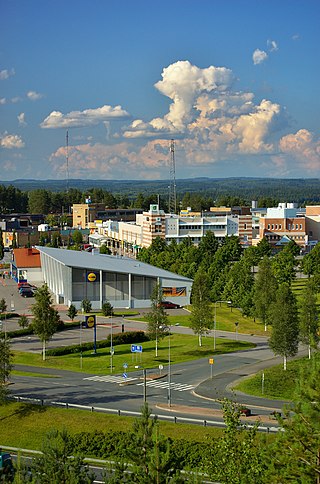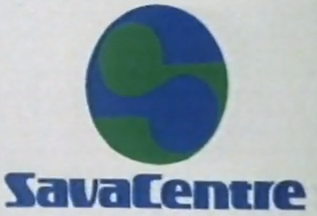
A supermarket is a self-service shop offering a wide variety of food, beverages and household products, organized into sections. This kind of store is larger and has a wider selection than earlier grocery stores, but is smaller and more limited in the range of merchandise than a hypermarket or big-box market. In everyday U.S. usage, however, "grocery store" is synonymous with provision store or supermarket, and is not used to refer to other types of stores that sell groceries.

Carrefour is a French multinational retail and wholesaling corporation headquartered in Massy, France. The eighth-largest retailer in the world by revenue, it operates a chain of hypermarkets, groceries stores and convenience stores, which as of December 2021, comprises its 13,894 stores in over 30 countries.

A grocery store (AE), grocery shop (BE) or simply grocery is a store that primarily retails a general range of food products, which may be fresh or packaged. In everyday U.S. usage, however, "grocery store" is a synonym for supermarket, and is not used to refer to other types of stores that sell groceries. In the UK, shops that sell food are distinguished as grocers or grocery shops.

A hypermarket is a big-box store combining a supermarket and a department store. The result is an expansive retail facility carrying a wide range of products under one roof, including full grocery lines and general merchandise. In theory, hypermarkets allow customers to satisfy all their routine shopping needs in one trip. The term hypermarket was coined in 1968 by French trade expert Jacques Pictet.
A discount store or discounter offers a retail format in which products are sold at prices that are in principle lower than an actual or supposed "full retail price". Discounters rely on bulk purchasing and efficient distribution to keep down costs.

ICA Gruppen AB (publ) is a Swedish retailer franchise with a focus on food and health. The group also owns a bank, real estate division and a pharmacy chain.

A big-box store is a physically large retail establishment, usually part of a chain of stores. The term sometimes also refers, by extension, to the company that operates the store. The term "big-box" references the typical appearance of buildings occupied by such stores.

Auchan is a French multinational retail group headquartered in Croix, France. It was founded in 1961 by Gérard Mulliez and is owned by the Mulliez family, who has 95% stake in the company. With 354,851 employees, of which 261,000 have 5% stake in the company, it is the 35th largest employer in the world.
Organización Soriana is a Mexican public company and a major retailer in Mexico with more than 824 stores. Soriana is a grocery and department store retail chain headquartered in Torreón, Coahuila de Zaragoza, Mexico. The company is 100% capitalized in Mexico and has been publicly traded on the Mexican stock exchange, since 1987 under the symbol: "Soriana".

Price Rite is a chain of supermarkets found in Connecticut, Maryland, Massachusetts, New Hampshire, New Jersey, New York, Pennsylvania, and Rhode Island. Based in Keasbey, New Jersey, Price Rite is owned by New Jersey-based Wakefern Food Corporation, the cooperative behind ShopRite Supermarkets, Dearborn Market, and The Fresh Grocer. Prior to 2014, Wakefern owned and operated all Price Rite stores.
Migros Ticaret A.Ş. is one of the biggest chains of supermarkets in Turkey.
Big C, is a grocery and general merchandising retailer headquartered in Bangkok, Thailand. Big C is as of 2016 Thailand's second-largest hypermarket operator after Lotus's. It has operations in four countries, namely Thailand, Vietnam, Laos and Cambodia.

SavaCentre was a chain of 13 hypermarkets and later a further seven discount supermarkets owned and operated jointly by Sainsbury's and BHS, beginning in 1977. Sainsbury's later took full control of the stores alone in 1989, rebranding them as Sainsbury's SavaCentre, until 2005 when the stores were integrated into the Sainsbury's supermarket brand. The hypermarket stores ranged in size from 66,000 sq ft (6,100 m2) to 117,000 sq ft (10,900 m2) and the discount supermarkets ranged in size from 31,000 sq ft (2,900 m2) to 70,000 sq ft (6,500 m2). At the time of its inception, it was the only dedicated hypermarket chain in the UK.
Sedmoi Kontinent is a major grocery retail chain operating 140 stores in Russia and one in Belarus. It is headquartered in Moscow.
X5 Group is Russia's largest food retailer.
Off-price is a trading format based on discount pricing. Off-price retailers are independent of manufacturers and buy large volumes of branded goods directly from them. The off-price retail model relies on the purchase of over-produced, or excess, branded goods at a lower price, thus being able to sell to consumers at a discount compared to other stores which purchased an initial run. Among the largest retailers of this type are TJX Companies and Ross Stores. The model is more common in countries that import fashion-oriented or household goods, as the discount role in producer countries is usually filled by factory outlets or small-scale open-air marketplaces.
Retailing in South Korea consists of hypermarkets, department stores, flea markets, traditional markets, and underground shopping malls. Hypermarkets sell dry goods and groceries, similar to Western supercentres. Traditional markets are also popular throughout South Korea.
The retail format influences the consumer's store choice and addresses the consumer's expectations. At its most basic level, a retail format is a simple marketplace, that is; a location where goods and services are exchanged. In some parts of the world, the retail sector is still dominated by small family-run stores, but large retail chains are increasingly dominating the sector, because they can exert considerable buying power and pass on the savings in the form of lower prices. Many of these large retail chains also produce their own private labels which compete alongside manufacturer brands. Considerable consolidation of retail stores has changed the retail landscape, transferring power away from wholesalers and into the hands of the large retail chains.
Samokat is a Russian dark store rapid delivery service for food and household goods. Founded in 2017, it was the first dark store operator in the country. By 2022, Samokat owned around 1,100 dark stores in 49 cities and handled 35% of dark store deliveries Russia-wide.








